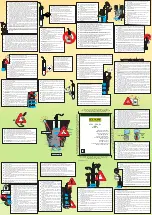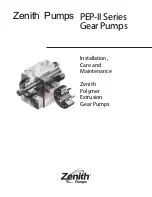
5 Installation
5.1 Installing the vacuum pump
CAUTION
Risk of injury from loss of stability
During setup, there is a risk of injury from tipping, if the vacuum pump is not anchored on the stand-
ing surface.
► Secure the vacuum pump using suitable lifting gear.
► Wear personal protective equipment.
General notes for the installation of vacuum components
► Choose an installation location that permits access to the product and to supply lines at all times.
► Observe the ambient conditions given for the area of use.
► Provide the highest possible level of cleanliness during assembly.
► Ensure that flange components during installation are grease-free, dust-free and dry.
Notes on installing the vacuum pump
1. Check the carrying capacity of the floor at the installation location.
2. Place the vacuum pump on a flat, horizontal and fixed surface, to safeguard the lubricant supply.
– Reference surface is the vacuum flange.
3. Screw the 4 feet of the vacuum pump on level with the standing surface.
4. When doing so, make sure that the vacuum pump is not tensioned.
5. When installing the pump in a closed housing, ensure adequate air circulation.
6. Keep both sight glasses freely accessible for checks and maintenance.
7. Ensure that the motor rating plate remains accessible at all times for a clear view of the voltage
and frequency specifications.
8. Maintain the minimum distances to bordering surfaces to guarantee sufficient air circulation.
9. Leave the filling/drain holes and sight glasses freely accessible.
10. Fill with lubricant prior to first commissioning.
5.2 Filling with lubricant
NOTICE
Property damage from using non-approved lubricant
Attainment of product-specific performance data is not ensured. If non-approved lubricant is used, all
liability and warranty claims against Pfeiffer Vacuum are excluded.
► Use approved lubricant only.
► Use other application-specific lubricant only after consultation with Pfeiffer Vacuum.
The lubricant type specified for the gear and bearing chamber as well as the respective filling quantity
are indicated on the rating plate. Subsequent change of the lubricant type is possible only after consul-
tation with Pfeiffer Vacuum.
Permissible lubricants
● P3 (standard design)
● D1 for special applications (such as higher operating temperatures)
● Other lubricants on request
Consumable
● Lubricant
Required tools
● Open-end wrench, 24 mm WAF
● Calibrated torque wrench (tightening factor ≤ 2.5)
Installation
21/56
















































